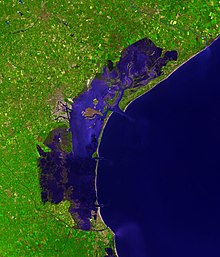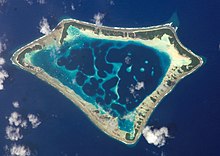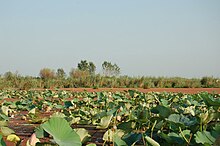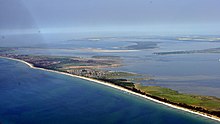Lagoon



A lagoon is a shallow
Definition and terminology
Lagoons are shallow, often elongated bodies of water separated from a larger body of water by a shallow or exposed shoal, coral reef, or similar feature. Some authorities include fresh water bodies in the definition of "lagoon", while others explicitly restrict "lagoon" to bodies of water with some degree of salinity. The distinction between "lagoon" and "estuary" also varies between authorities. Richard A. Davis Jr. restricts "lagoon" to bodies of water with little or no fresh water inflow, and little or no tidal flow, and calls any bay that receives a regular flow of fresh water an "estuary". Davis does state that the terms "lagoon" and "estuary" are "often loosely applied, even in scientific literature".[1] Timothy M. Kusky characterizes lagoons as normally being elongated parallel to the coast, while estuaries are usually drowned river valleys, elongated perpendicular to the coast.[1][2][3][4][5] Coastal lagoons are classified as inland bodies of water.[6][7]
When used within the context of a distinctive portion of coral reef ecosystems, the term "lagoon" is synonymous with the term "back reef" or "backreef", which is more commonly used by coral reef scientists to refer to the same area.[8]
Many lagoons do not include "lagoon" in their common names.
In some languages the word for a lagoon is simply a type of lake: In Chinese a lake is hu (湖), and a lagoon is xihu (潟湖). In the
Some languages differentiate between coastal and atoll lagoons. In French, lagon refers specifically to an atoll lagoon, while coastal lagoons are described as étang, the generic word for a still lake or pond. In Vietnamese, Đầm san hô refers to an atoll lagoon, whilst Đầm phá is coastal.
In Latin America, the term laguna in Spanish, which lagoon translates to, may be used for a small fresh water lake in a similar way a creek is considered a small river. However, sometimes it is popularly used to describe a full-sized lake, such as Laguna Catemaco in Mexico, which is actually the third-largest lake by area in the country. The brackish water lagoon may be thus explicitly identified as a "coastal lagoon" (laguna costera). In Portuguese, a similar usage is found: lagoa may be a body of shallow seawater, or a small freshwater lake not linked to the sea.
Etymology
Lagoon is derived from the
Atoll lagoons

Atoll lagoons form as coral reefs grow upwards while the islands that the reefs surround subside, until eventually only the reefs remain above sea level. Unlike the lagoons that form shoreward of fringing reefs, atoll lagoons often contain some deep (>20 m (66 ft)) portions.
Coastal lagoons


Coastal lagoons form along gently sloping coasts where barrier islands or reefs can develop offshore, and the sea-level is rising relative to the land along the shore (either because of an intrinsic rise in sea-level, or subsidence of the land along the coast). Coastal lagoons do not form along steep or rocky coasts, or if the range of tides is more than 4 metres (13 ft). Due to the gentle slope of the coast, coastal lagoons are shallow. A relative drop in sea level may leave a lagoon largely dry, while a rise in sea level may let the sea breach or destroy barrier islands, and leave reefs too deep underwater to protect the lagoon. Coastal lagoons are young and dynamic, and may be short-lived in geological terms. Coastal lagoons are common, occurring along nearly 15 percent of the world's shorelines. In the United States, lagoons are found along more than 75 percent of the Eastern and Gulf Coasts.[3][4]
Coastal lagoons are usually connected to the open ocean by inlets between barrier islands. The number and size of the inlets, precipitation, evaporation, and inflow of fresh water all affect the nature of the lagoon. Lagoons with little or no interchange with the open ocean, little or no inflow of fresh water, and high evaporation rates, such as Lake St. Lucia, in South Africa, may become highly saline. Lagoons with no connection to the open ocean and significant inflow of fresh water, such as the Lake Worth Lagoon in Florida in the middle of the 19th century, may be entirely fresh. On the other hand, lagoons with many wide inlets, such as the Wadden Sea, have strong tidal currents and mixing. Coastal lagoons tend to accumulate sediments from inflowing rivers, from runoff from the shores of the lagoon, and from sediment carried into the lagoon through inlets by the tide. Large quantities of sediment may be occasionally be deposited in a lagoon when storm waves overwash barrier islands. Mangroves and marsh plants can facilitate the accumulation of sediment in a lagoon. Benthic organisms may stabilize or destabilize sediments.[3][4] Lake Chilika is the largest brackish water lagoon in Asia and the second largest coastal lagoon in the world.
Largest coastal lagoons
This section may contain embedded lists. by removing items or incorporating them into the text of the article. (October 2023) |
- New Caledonian lagoon: 24,000 km2 (9,300 sq mi)
- Garabogazköl: 18,000 km2 (6,900 sq mi)
- Lake Maracaibo: 13,512 km2 (5,217 sq mi)
- Lagoa dos Patos: 10,100 km2 (4,000 sq mi)
- Albemarle-Pamlico sound system: 7,800 km2 (3,000 sq mi)
- Curonian lagoon: 1,619 km2 (625 sq mi)
- Mayotte lagoon: ~1,500 km2 (600 sq mi)
- Rangiroa lagoon: 1,446 km2 (600 sq mi)
- Chilika Lake: 1,165 km2 (450 sq mi) during monsoon season, 906 km2 (350 sq mi) during dry season
- Vistula lagoon: 838 km2 (324 sq mi)
- Marovo lagoon: 700 km2 (300 sq mi)
- Szczecin Lagoon : 689 km2 (266 sq mi)
- Venetian lagoon: 550 km2 (210 sq mi)
Regulation
In the European Union, coastal lagoon habitat is classified and under Directive 92/43/EEC on the conservation of natural habitats and wild flora and fauna (Habitats Directive). Furthermore, numerous bird species breed in coastal lagoons. As a result, many lagoons are also protected under Directive 2009/147/EC on the conservation of birds (Birds Directive).
Images
-
Brazilian state of Rio Grande do Sul.
-
Aerial view of Bora Bora in French Polynesia.
-
Aerial view of Kivalina, Alaska from the northwest.
-
Nearly half the area of Kiritimati is covered with lagoons, some freshwater and some seawater.
-
Panoramic view of Lefkada City Lagoon, Lefkada Isl., Ionian Islands Prefecture, Greece.
-
Panoramic view of Prokopos Lagoon,Achaia, Western Greece Prefecture, Greece.
-
Tropical lagoon in Bacuit Bay, Palawan, Philippines.
-
Photo of Mar Menor as seen from International Space Station.
See also
References
- ^ ISBN 978-0-7167-5042-0.
- ISBN 978-0-19-921194-4.
- ^ ISBN 0-8160-4973-4.
- ^ ISBN 0-7172-5946-3.
- ASIN B003MRW6AK.
- ISBN 978-1-4020-1903-6. Retrieved 31 March 2012.
- ISBN 978-0-444-88258-5.
- S2CID 879073.
- doi:10.1029/2011JC007124. Archived from the originalon Aug 19, 2014. Retrieved 24 March 2012.
- ^ Goodbred, S. Jr., P. Locicero, V. Bonvento, S. Kolbe, S. Holsinger. "History of the Great South Bay estuary:Evidence of a catastrophic origin". State University of New York. Retrieved 24 March 2012.
{{cite web}}: CS1 maint: multiple names: authors list (link) - S2CID 14978943. Retrieved 24 March 2012.)
{{cite journal}}: CS1 maint: multiple names: authors list (link - ^ "Total Maximum Daily Loads for the North and Central Indian River Lagoon and Banana river Lagoon, Florida" (PDF). United States Environmental Protection Agency. Archived from the original (PDF) on 24 September 2015. Retrieved 24 March 2012.
- ^ "Proposed Swimming Enclosure Net, Entrance Lagoon, Lake Illawarra" (PDF). Lake Illawarra Authority. Archived from the original (PDF) on 28 February 2011. Retrieved 24 March 2012.
- ISBN 978-1-4020-8638-0.
- ISBN 0-478-21947-4.)
{{cite book}}: CS1 maint: multiple names: authors list (link - ^ "Lagoon". Oxford English Dictionary. Vol. I A-O (Compact ed.). Oxford, England: Oxford University Press. 1971. p. 1560.













